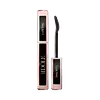What's inside
What's inside
 Key Ingredients
Key Ingredients

No key ingredients
 Benefits
Benefits

 Concerns
Concerns

 Ingredients Side-by-side
Ingredients Side-by-side

Water
Skin ConditioningCetyl Alcohol
EmollientGlycerin
HumectantAloe Barbadensis Leaf Juice
Skin ConditioningBehentrimonium Chloride
PreservativeTheobroma Cacao Seed Butter
EmollientMangifera Indica Seed Butter
Skin ConditioningCitrus Reticulata Peel Oil
MaskingAngelica Archangelica Extract
Skin ConditioningHydrolyzed Wheat Protein
Skin ConditioningIsopropyl Alcohol
SolventCetrimonium Chloride
AntimicrobialPhenoxyethanol
PreservativeBenzoic Acid
MaskingDehydroacetic Acid
PreservativePotassium Sorbate
PreservativeSodium Hydroxide
BufferingParfum
MaskingBenzyl Benzoate
AntimicrobialLimonene
PerfumingWater, Cetyl Alcohol, Glycerin, Aloe Barbadensis Leaf Juice, Behentrimonium Chloride, Theobroma Cacao Seed Butter, Mangifera Indica Seed Butter, Citrus Reticulata Peel Oil, Angelica Archangelica Extract, Hydrolyzed Wheat Protein, Isopropyl Alcohol, Cetrimonium Chloride, Phenoxyethanol, Benzoic Acid, Dehydroacetic Acid, Potassium Sorbate, Sodium Hydroxide, Parfum, Benzyl Benzoate, Limonene
Water
Skin ConditioningPropylene Glycol
HumectantStyrene/Acrylates/Ammonium Methacrylate Copolymer
Polyurethane-35
Cera Alba
EmollientSynthetic Fluorphlogopite
Glyceryl Stearate
EmollientCetyl Alcohol
EmollientPEG-200 Glyceryl Stearate
Ethylenediamine/Stearyl Dimer Dilinoleate Copolymer
Skin ConditioningCopernicia Cerifera Cera
EmollientStearic Acid
CleansingPalmitic Acid
EmollientEthylene/Va Copolymer
Emulsion StabilisingAlcohol Denat.
AntimicrobialCamellia Sinensis Leaf Extract
AntimicrobialParaffin
PerfumingGlycerin
HumectantSodium Laureth Sulfate
CleansingMyristic Acid
CleansingAminomethyl Propanediol
BufferingDisodium EDTA
Hydroxyethylcellulose
Emulsion StabilisingCaprylic/Capric Triglyceride
MaskingCaprylyl Glycol
EmollientTetrasodium EDTA
Xanthan Gum
EmulsifyingButylene Glycol
HumectantPentaerythrityl Tetra-Di-T-Butyl Hydroxyhydrocinnamate
AntioxidantPotassium Sorbate
PreservativePhenoxyethanol
PreservativeCI 77499
Cosmetic ColorantWater, Propylene Glycol, Styrene/Acrylates/Ammonium Methacrylate Copolymer, Polyurethane-35, Cera Alba, Synthetic Fluorphlogopite, Glyceryl Stearate, Cetyl Alcohol, PEG-200 Glyceryl Stearate, Ethylenediamine/Stearyl Dimer Dilinoleate Copolymer, Copernicia Cerifera Cera, Stearic Acid, Palmitic Acid, Ethylene/Va Copolymer, Alcohol Denat., Camellia Sinensis Leaf Extract, Paraffin, Glycerin, Sodium Laureth Sulfate, Myristic Acid, Aminomethyl Propanediol, Disodium EDTA, Hydroxyethylcellulose, Caprylic/Capric Triglyceride, Caprylyl Glycol, Tetrasodium EDTA, Xanthan Gum, Butylene Glycol, Pentaerythrityl Tetra-Di-T-Butyl Hydroxyhydrocinnamate, Potassium Sorbate, Phenoxyethanol, CI 77499
 Reviews
Reviews

Ingredients Explained
These ingredients are found in both products.
Ingredients higher up in an ingredient list are typically present in a larger amount.
Cetyl Alcohol is a fatty alcohol. Fatty Alcohols are most often used as an emollient or to thicken a product.
Its main roles are:
Though it has "alcohol" in the name, it is not related to denatured alcohol or ethyl alcohol.
The FDA allows products labeled "alcohol-free" to have fatty alcohols.
Learn more about Cetyl AlcoholGlycerin is already naturally found in your skin. It helps moisturize and protect your skin.
A study from 2016 found glycerin to be more effective as a humectant than AHAs and hyaluronic acid.
As a humectant, it helps the skin stay hydrated by pulling moisture to your skin. The low molecular weight of glycerin allows it to pull moisture into the deeper layers of your skin.
Hydrated skin improves your skin barrier; Your skin barrier helps protect against irritants and bacteria.
Glycerin has also been found to have antimicrobial and antiviral properties. Due to these properties, glycerin is often used in wound and burn treatments.
In cosmetics, glycerin is usually derived from plants such as soybean or palm. However, it can also be sourced from animals, such as tallow or animal fat.
This ingredient is organic, colorless, odorless, and non-toxic.
Glycerin is the name for this ingredient in American English. British English uses Glycerol/Glycerine.
Learn more about GlycerinPhenoxyethanol is a preservative that has germicide, antimicrobial, and aromatic properties. Studies show that phenoxyethanol can prevent microbial growth. By itself, it has a scent that is similar to that of a rose.
It's often used in formulations along with Caprylyl Glycol to preserve the shelf life of products.
Potassium Sorbate is a preservative used to prevent yeast and mold in products. It is commonly found in both cosmetic and food products.
This ingredient comes from potassium salt derived from sorbic acid. Sorbic acid is a natural antibiotic and effective against fungus.
Both potassium sorbate and sorbic acid can be found in baked goods, cheeses, dried meats, dried fruit, ice cream, pickles, wine, yogurt, and more.
You'll often find this ingredient used with other preservatives.
Learn more about Potassium SorbateWater. It's the most common cosmetic ingredient of all. You'll usually see it at the top of ingredient lists, meaning that it makes up the largest part of the product.
So why is it so popular? Water most often acts as a solvent - this means that it helps dissolve other ingredients into the formulation.
You'll also recognize water as that liquid we all need to stay alive. If you see this, drink a glass of water. Stay hydrated!
Learn more about Water